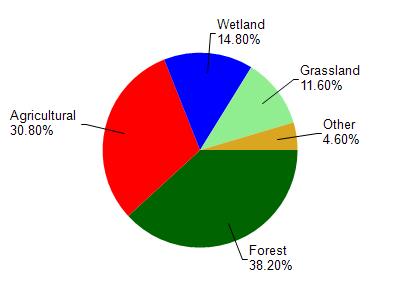Marquette
No
No
No
Fish and Aquatic Life
Historical Description
Widow Green (O'Keefe) Creek, TgN, R7E, Section 12, Surface Acres = 6.3, Miles = 6.5, Gradient =14.1 feet per mile.
This is a clear, hard water stream having a predominantly silt bottom. It flows in a
general southeasterly direction into Marquette County. The stream heads in a licensed
private fish hatchery pond, but during the 1965 investigation, no water was flowing out of
the pond and the stream was intermittent for a distance of approximately one and
one-half miles. The stream is considered brown trout water, but a past survey found few
trout. Forage fish species dominate. During the February, 1963, aerial groundwater
survey, open water was observed from the Marquette County line upstream for a distance
of three miles. There are 83 acres of adjoining wetland. Several road crossings
provide public access.
From: Klick, Thomas A. and C.W. Threinen. 1966. Surface Water Resources of Adams County:
Lake and Stream Classification Project. Wisconsin Conservation Department, Madison, WI.
Date 1966
Author Surface Water Inventory Of Wisconsin
Historical Description
Widow Green Creek, T14N, R8E. Section 21, Surface Acres = 11.0, Miles = 5.5, Gradient = 2.4 feet per mile.
A clear stream of low-gradient which flows through marshland in Marquette County to Neenah Creek northeast of Briggsville About 1.25 miles are considered as sustaining trout. A large, deep marsh area along the stream is commonly called Mud Lake on older maps, but is no longer considered as a lake. Access is possible from two county highway crossings. Waterfowl are frequently encountered as are marsh furbearers.
From: Poff, Ronald J. and Threinen, C.W., 1963. Lake and Stream Classification Project. Surface Water Resources of Marquette County, Wisconsin Department of Natural Resources, Madison, WI.
Date 1963
Author Surface Water Inventory Of Wisconsin
General Condition
O'Keefe Creek (WBIC 176800) from Mud Lake to the headwaters was assessed during the 2018 listing cycle; new biological (fish Index of Biotic Integrity (IBI) scores) and temperature sample data were clearly below the 2018 WisCALM listing thresholds for the Fish and Aquatic Life use. This water was meeting this designated use and was not considered impaired.
Date 2017
Author Ashley Beranek
Condition
Wisconsin has over 84,000 miles of streams, 15,000 lakes and milllions of acres of wetlands. Assessing the condition of this vast amount of water is challenging. The state's water monitoring program uses a media-based, cross-program approach to analyze water condition. An updated monitoring strategy (2015-2020) is now available. Compliance with Clean Water Act fishable, swimmable standards are located in the Executive Summary of Water Condition in 2018. See also the 'monitoring and projects' tab.
Reports
Recommendations
Restore Wetlands
Restore Wetlands
Management Goals
Wisconsin's Water Quality Standards provide qualitative and quantitative goals for waters that are protective of Fishable, Swimmable conditions [Learn more]. Waters that do not meet water quality standards are considered impaired and restoration actions are planned and carried out until the water is once again fishable and swimmable
Management goals can include creation or implementation of a Total Maximum Daily Load analysis, a Nine Key Element Plan, or other restoration work, education and outreach and more. If specific recommendations exist for this water, they will be displayed below online.
Monitoring
Monitoring the condition of a river, stream, or lake includes gathering physical, chemical, biological, and habitat data. Comprehensive studies often gather all these parameters in great detail, while lighter assessment events will involve sampling physical, chemical and biological data such as macroinvertebrates. Aquatic macroinvertebrates and fish communities integrate watershed or catchment condition, providing great insight into overall ecosystem health. Chemical and habitat parameters tell researchers more about human induced problems including contaminated runoff, point source dischargers, or habitat issues that foster or limit the potential of aquatic communities to thrive in a given area. Wisconsin's Water Monitoring Strategy was recenty updated.
Grants and Management Projects
Monitoring Projects
| WBIC | Official Waterbody Name | Station ID | Station Name | Earliest Fieldwork Date | Latest Fieldwork Date | View Station | View Data |
|---|
| 176800 | O'Keefe Creek | 10020803 | Widow Green Cr.-Rocks Under Downstream End Of Bridge-Proceed Upstream Under Bridge On County A. | | | Map | Data |
| 176800 | O'Keefe Creek | 10016664 | Widow Green - 0 | 4/24/1980 | 5/13/1992 | Map | Data |
| 176800 | O'Keefe Creek | 10048933 | O' Keefe Creek - CTH A | 8/9/2005 | 8/9/2005 | Map | Data |
|

Watershed Characteristics
O'Keefe Creek is located in the Neenah Creek watershed which is 173.35 mi². Land use in the watershed is primarily forest (38.20%), agricultural (30.80%) and a mix of wetland (14.80%) and other uses (16.20%). This watershed has 198.75 stream miles, 2,104.14 lake acres and 14,499.98 wetland acres.
Nonpoint Source Characteristics
This watershed is ranked Not Available for runoff impacts on streams, Not Ranked for runoff impacts on lakes and High for runoff impacts on groundwater and therefore has an overall rank of High. This value can be used in ranking the watershed or individual waterbodies for grant funding under state and county programs.However, all waters are affected by diffuse pollutant sources regardless of initial water quality. Applications for specific runoff projects under state or county grant programs may be pursued. For more information, go to surface water program grants.